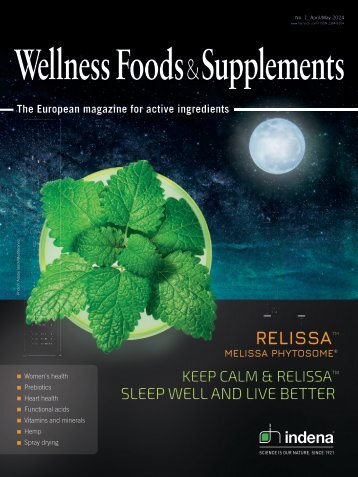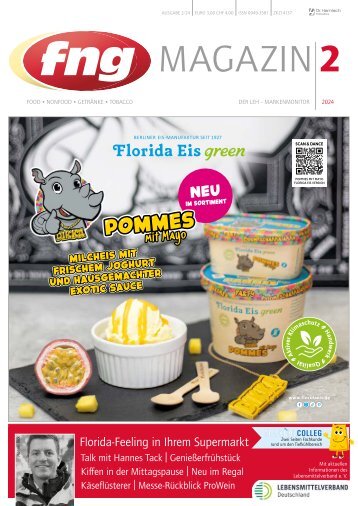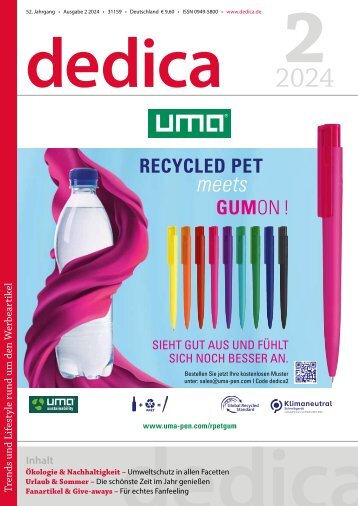Wellness Foods & Supplements 3/2020
- Text
- Harnischcom
- Supplements
- Foods
- Wellness
- Clinical
- Salts
- Protein
- Dairy
- Vaginal
- Products
- Yogurt
- Mineral
- Calcium
- Magnesium
Fortified dairy
Fortified dairy alternatives Dairy products are the most important source of calcium in our diet and provide 52–65 % of daily calcium requirements. 10,13 Milk contains 120 mg calcium per 100 ml, whereas most plant-based alternatives contain significantly less. Soy drinks, for instance, contains only 25 mg calcium per 100 ml and coconut drink contains 0 mg per 100 ml. 14,15 Other minerals, such as magnesium and zinc, are only present in small quantities in many dairy alternatives. People who do not consume milk-based products typically have a lower intake of these minerals and are therefore at a higher risk of inadequacy. 11 Enrichment of milk alternatives can therefore make an important contribution to a healthy diet. Challenges in the production of fortified dairy alternatives When enriching milk alternatives, it’s very important to consider the various properties of the mineral salts in question. Soluble calcium salts in particular, such as calcium lactate or calcium chloride, can lead to interactions with proteins due to the high concentration of free calcium ions. This can affect the pH value and stability of the product when it is heat treated. Insoluble inorganic salts such as calcium carbonate or calcium phosphate do not have this problem, but can precipitate or cause a sandy mouthfeel. Tricalcium citrate is a good compromise. It has a solubility of approx. 1 g/l and exhibits inverse solubility: solubility decreases as temperature increases, so only a very low concentration of free calcium ions is present during the heat treatment process. 16 Jungbunzlauer offers tricalcium citrate in a micronised grade (M1098: min. 98 % < 10 μm). Due to the very fine particle size, sedimentation is less pronounced and the product offers a pleasant mouthfeel, since the particles are too small to be detected on the tongue. Magnesium salts are less common in fortifying dairy alternatives. During processing, their behaviour is similar to that of calcium salts, but less mineral salt is required because the recommended daily intake for magnesium is lower than for calcium. 5 As a result, magnesium salts have less severe negative impacts on the product than calcium salts. Among the neutral-tasting magnesium salts, trimagnesium citrate offers the highest mineral content, but the insoluble inorganic salt magnesium phosphate has been used more often because of its neutral taste and low price. However, consumers are becoming increasingly sceptical about phosphate-containing ingredients. Various studies have indicated that excessive consumption of phosphates from food additives can be associated with health risks. The EFSA therefore called for an upper limit on phosphate levels in a new risk assessment in 2019. 17 Fortifying with minerals, masking unpleasant flavours Unpleasant off-tastes can be a problem, especially with plant-based products: plant proteins can have a beany, green or bitter taste, making the product less attractive for the consumer. Previous trials have shown that mineral salts of organic acids – such as citrate or gluconate salts of magnesium, sodium or potassium – can mask bitterness and other unpleasant flavours. 18 Fortification with mineral salts can therefore improve not only the mineral content but also the taste of milk alternatives. The effect of each mineral salt on the flavour can vary depending on the matrix and the source of plant protein used: the mineral salt with the largest impact on offnotes in the flavour of one product may have much less effect in another. Before examining the taste-masking properties of mineral salts, it is essential to identify the dominant taste characteristics of the various plant materials. To cover as wide a range of off-notes as possible, a soy drink and a walnut drink were selected as basis drinks to which mineral salts were added. Screening for off-notes The first step involved a benchmark soy drink (consisting of only water and 9 % soy) and a self-prepared walnut drink (5 % nut content; for recipe see table 2) being screened by an internal sensory panel. These screenings were carried out in form of a CATA (‘check all that apply’) test. CATA is a rapid descriptive method in which the panellists are given a list of attributes and are asked to determine which attributes, as perceived by the panellists, are most relevant to the samples. Quantitative results were then produced by counting the frequency of each attribute for each sample. The aim of these sessions was to find the most relevant attribute for subsequent discrimination tests. The panellists identified the beany notes in the soy drink and the bitter notes in the walnut drink as the most dominant off-notes. Following these screenings, paired comparison tests were carried out to analyse the soy drink and the walnut drink, focusing on the two attributes identified by the panellists. As well as the paired comparison test, the panellists were asked to identify their preference and to comment on their impression of the taste. This additional information did not form part of a representative consumer test. 34 No. 3 November/December 2020
Fortified dairy alternatives Minerals for masking unpleasant flavours in milk alternatives Experimental setup For each comparison test of the soy drink, the panellists were given a plain soy drink sample and a sample containing 0.15% added mineral salt (sodium gluconate, trimagnesium citrate, tripotassium citrate, calcium lactate gluconate or potassium lactate). The panellists were asked to identify which sample they perceived as more beany. The same test setup was also used to evaluate the taste-masking properties of mineral salts in walnut drinks. Here, the panellists were asked to identify which sample they perceived as more bitter. The test was carried out as a blind experiment; all samples were randomised and identified only by three-digit codes. The soy drink was commercially available and was used both with and without added mineral salts. The walnut test matrix was prepared and fortified with one of the mineral salts afterwards. Table 3: Sensory evaluation of soy drink – comments by panellists Walnut drink results The addition of 0.15 % sodium gluconate, trimagnesium citrate, calcium lactate gluconate and potassium lactate significantly reduced the bitter off-note of the walnut drink (n = 20, α = 0.05). The panellists also preferred these samples over the plain walnut drink. Table 4: Sensory evaluation of walnut drink – comments by panellists Conclusion The sensory tests conducted showed that minerals are not only valuable for mineral fortification of milk substitutes but may also be suitable for masking undesired off-tastes. The results also indicated how crucial the selection of the right mineral salt is for masking specific off-notes. Table 2: Recipe for walnut drink The first step in preparing the walnut drink involved mixing the stabilisers with a quarter of the required amount of water. Another quarter of the water was heated to 60° C and mixed with lecithin. Both solutions were stirred thoroughly for 30 minutes. The walnut paste was meanwhile soaked at 60° C in the rest of the water. This mixture was then transferred to a Becomix ® and reheated to 60° C. The lecithin solution was homogenised, and then the lecithin solution and the stabiliser solution were stirred into the walnut-water mixture. The resulting mixture was homogenised at 60° C and then had its pH adjusted to 7.0. Finally, the product was pasteurised. Soy drink results The addition of 0.15% sodium gluconate, trimagnesium citrate or tripotassium citrate significantly reduced the beany off-note in the soy drink (n = 20, α = 0.05). The samples containing sodium gluconate and trimagnesium citrate were preferred over the plain soy drink. While 0.15 % tripotassium citrate worked well for masking beany off-notes of the soy drink, calcium lactate gluconate and potassium lactate worked well for the bitter off-note of the walnut drink. Sodium gluconate and trimagnesium citrate masked both off-notes. At a concentration of 0.15 %, trimagnesium citrate fulfils a dual function: its addition allows the product to be claimed as a source of magnesium, and it also helps enhance the taste of the product by masking beany and bitter off-notes. Mineral fortification in non-dairy yoghurt As described above, specific minerals can be utilised as taste masking agents for undesired off-notes in soy and walnut drinks. While milk alternatives are often fortified so that their mineral content matches that of cow’s milk, fortification of non-dairy yoghurt can go further. Yoghurt products are generally considered healthy and their set portion size allows them to be used as an important source of minerals. Therefore yoghurt fortification can be used to achieve “high in minerals” status – an especially interesting option for vegan yoghurts. However, since non-dairy yoghurts are produced directly from milk alternatives, additional minerals could have a negative effect on the stability, texture and taste of plant-based yoghurts. The following trials No. 3 November/December 2020 35
- Seite 1: No. 3, November/December 2020 www.h
- Seite 4 und 5: Contents Health Convenience Food Fo
- Seite 6 und 7: Oils and fats Photo © : 123rf/jirk
- Seite 8 und 9: Oils and fats sive “key figure”
- Seite 10 und 11: Functional sugars Photo © : Jennew
- Seite 12 und 13: Nutrition and ageing Photo © : Ado
- Seite 14 und 15: Nutrition and ageing demineralizati
- Seite 16 und 17: Nutrition and ageing Proferrin ® ,
- Seite 18 und 19: Energy and endurance system is conn
- Seite 20 und 21: Minerals Photo ® : Adobe Stock/nd3
- Seite 22 und 23: Minerals Health Claims Magnesium co
- Seite 24 und 25: Women‘s health Probiotics for wom
- Seite 26 und 27: Women‘s health How can oral probi
- Seite 28 und 29: Clinical trials Photo ® : Adobe St
- Seite 30 und 31: Clinical trials methods; and the sa
- Seite 32 und 33: Fortified dairy alternatives Minera
- Seite 36 und 37: Fortified dairy alternatives theref
- Seite 38 und 39: Fortified dairy alternatives instea
- Seite 40 und 41: Dairy products lactose digestion”
- Seite 42 und 43: Dairy products EPILAC premium yogur
- Seite 44: Come and see for yourself: www.harn
Unangemessen
Laden...
Magazin per E-Mail verschicken
Laden...
Einbetten
Laden...































































































































































































































































































